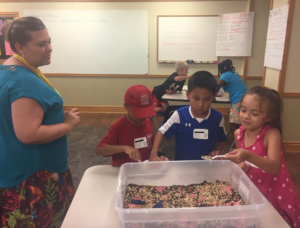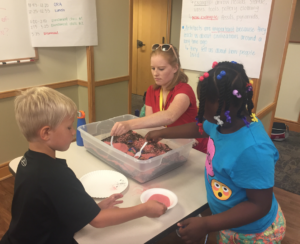Summer SAVY 2018: Session 4, Day 4 – Traveling Through Time (Rising 2nd)
We’re finished with Day 4 already!! What an awesome week we have had so far! Today, we reviewed what we have learned so far using a huge concept map and word wall that Ms. Emily put together. I was really excited with how much our students have retained! They are transforming into skilled archaeologists right before our eyes! Next, we discussed the Maya political structure in greater detail and talked about the role that a person’s social status played in how that person contributed to the political network of the city. We also discussed how archaeologists use stratigraphy (the layers of soil deposited after a site is abandoned), to understand archaeological sites. Archaeologists use the Law of Superimposition, which states that the oldest materials will be deposited at the bottom, while the younger materials will be at the top. We followed this with a fun activity where we buried our mock Maya site with several layers of soil and sand. This activity modeled the ways that natural processes (such as soil deposition and erosion), and cultural processes (human occupation) can affect the state of an archaeological site and how it comes to be in the state that archaeologists find it in the present.
We also spent some time planning for the Open House tomorrow! Ms. Emily and I are SO excited to have you come and visit our classroom tomorrow! Our students have done an incredible job and are really proud to show you the work they have done all week!
Here are a few discussion questions you can discuss with your students tonight:
1. Who made up 95% of the population at most Maya sites? What role did this group play in the social, economic, and political system?
2. What is stratigraphy? Why is it important that archaeologists understand the stratigraphy at the archaeological sites they study?
3. What is one reason that an archaeologist might decide NOT to excavate an archaeological site?
Thanks very much!
Phyllis Johnson
Burying Our Artifacts for Later Excavations



